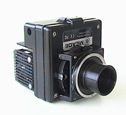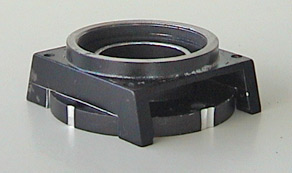| Stabilized cooling back for DSI... To solve the problem of condensation. | | |
|  | Read this page in french ...
| | |
|  | | |
| |
| A very beautiful accessory was developed for cameras MEADE™ DSI, by Steve MOGG : a stabilized cooling back. | |
| |
| Some technical information... | | |
| |
| This accessory is very quite designed and perfectly adapted to its main target ... "Control and stabilization of the CCD temperature" and not pure and hard cooling.
Explanations : The DSI and the DSI pro, in fact, do not need to be cooled because of their original mode of operation and even less with the new version of the software "Envisage". But on the other hand the problem is the management of the darks. The result is very sensitive to the temperature.
On the one hand, temperature when the darks are captured and on the other hand to that when capturing the image to which the dark is applied.
... if you see what I mean ;o)
It is thus very interesting to be able to guarantee the equality of these two temperatures. Some solve the problem by constituting series of darks at various temperatures...
But the solution is obviously the regulation of a choosen temperature. And thus the "Steve MOGG" cooling back
The Outback Cooler Installation Procedure of this accessory is simple... but its use induced to guard itself against an adverse effect of cooling... DEW ! ... or worse, white frost on the CCD's window.
I present my solution here. It applies to a DSI-Pro and is based on the use of a rather uncommon part : the nose piece of a ST4 camera unfortunately prematurely deceased ... RIP.
Naturally everyone does not have this object ... I presume ;o) However the idea seems to me easily adaptable to, for example a "T" adapter, that it is bought for the occasion or recovered on a DSI. Concerning Dsi-c the problem is much easier to solve. The adapter "T" and IRB filter can easily be sealed. | | |
|  | |
| The modification ... | | |
| The "tunnel" of the filters slider of the DSI-Pro is dismounted and modified to be adjusted perfectly... let's say "as much as possible", with the piece which will make "tight room". Here the pre mentioned ST4 adapter which include a clear sealed glass, as well as an O ring in its base (two reasons which made me choose this part). One sees here the grove which receives this joint.
I was obliged to envisage the passage of the fastening screws of the "tunnel" on the front face of the camera. With a "T" adapter this would not be necessary. In the same way the modification of the "tunnel" would be simpler... I believe. | | |
|  | | |
 | |  | | |
| These two images show the two parts which imbricate one in the other. Place the cursor on the right one for better seeing this assembly....
The "tunnel" will be machined in order to exert a pressure on the basis of other part in order to crush the O ring (visible on the image of left) and to ensure the sealing thus. I hope it makes sens ? | | |
|  | | |
| Here the components before assembly.
One notices IRB filter recovered of Dsi-c, cut out and stuck in a tight way in front of the sensor.
CAUTION: before doing this do not forget to very carefully clean the CCD's window AND the inside face of the filter.
One can always clean them afterwards, but it will be necessary to open the camera | | |
|  | | |
| Here the assembled unit.
One notices on the images that the 1"1/4 ST4 nose piece was shortened not to exceed the bottom of the Ø42 thread this makes it possible to preserve the possibility of screwing the adapter provided with the camera. | |
|  | | |
| Thus modified the sensor is isolated from the external air by two tight "rooms". | | |
|  | |
| And about the filter drawer ?... Of course, it will have to be replaced by a filter wheel ...
... if however you have the use of it...
| |
| The debate ... ;o) | | |
| |
| Is it necessary it "to seal" the whole of the camera's case?
The question can make debate, but as far as I'm concerned, I do not think so.
The sensor being isolated from the interior of the camera by a seal which is pressed against the internal face of the case, assuming that this joint is correctly placed, the air can't circulate from the interior towards the tight "rooms" we built...
This is verified in practice since, in spite of "tropical" ambient moisture and a temperature of 10°C on the sensor (with 25°C ambient), I get no mist on the CCD. | | |
| |
| As indicated at the beginning of this page and as it is very often the case, this modification is obviously not applicable "just as it is"... I think however that the idea can be easily adapted.
Good work ! Oh ! BTW ... you read this from top to the bottom ... you didn't "LOL" about my english ... you understood something ... Thank you ! ;o) | |
| Back to "Matériel" | |  | | |
| | | | | | | | | | | | | | | | | | | | | | | | | | | | | | |









